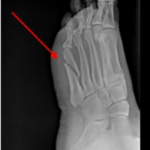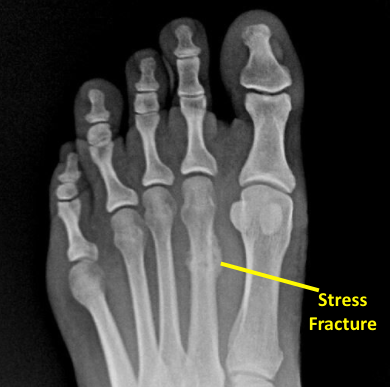Fractures
Watch the video above to learn about Fractures, and how I approach treating this with my patients. There's also more information below. As always, when you're ready, fill out the form on this page to request a consultation.


A fracture is defined as a break in a bone. Fractures are separated into two categories, traumatic/acute fractures or stress fractures.
A traumatic/acute fracture refers to a fracture that results from an acute injury. This results from a direct impact on the bone. An example of an acute fracture is stepping off of a curb and twisting the foot resulting in a fracture of the 5th metatarsal bone. These types of fractures can be non-displaced or displaced. In a displaced fracture, the normal alignment of the bone is changed and patients can sometimes see a deformity of the involved bone. In a non-displaced fracture, normal alignment is maintained
Symptoms of a traumatic/acute fracture include:
- Pain and swelling
- Bruising (ecchymosis)
- Foot and/or ankle deformity including angulation or joint dislocation
- Hearing a cracking or popping sound at the time of injury
A stress fracture, which results from repetitive stress on the bone, is a hairline fracture along the cortex of the bone. Stress fractures are very common in athletes or physically active individuals. Stress fractures commonly occur in the metatarsal bones in the foot and in the tibia in the lower leg. They typically result from overuse. Patients with osteoporosis are also subject to stress fractures.
Symptoms of stress fracture include:
- Swelling, generally chronic in nature
- Focal pain
- Pain that occurs with activity and resolves with inactivity or rest
- Throbbing and aching pain
Treatment of traumatic/acute fractures
The severity of the fracture dictates the treatment of traumatic/acute fractures. Non-displaced fractures are typically treated with a period of immobilization. The location of the fracture will dictate the type of immobilization required. Forms of immobilization include a cast with crutches, a walking cast, a walking boot, or a hard soled surgical shoe. Fractures generally take six weeks to heal, yet this time frame can be longer depending on co-morbidities and compliance.
Certain fractures will require surgical correction and Dr. Stewart will determine if you need surgery. The goal of surgery is to reduce the fracture to anatomic position and this is accomplished with screws, plates, and wires.
Treatment of stress fractures
Stress fractures result from overuse and therefore limiting physical activity is a key component of fracture healing. Immobilization of the foot and/or ankle is required as well and is accomplished with a cast, walking cast, walking boot or a hard soled surgical shoe. Compression therapy with prescription compression stockings is generally recommended to control swelling. Ice and elevation is on a daily basis is recommended as well. Stress fractures generally take six weeks to heal. Noncompliance and co-morbidities can delay fracture healing. Non-compliance can result in a stress fracture turning into a complete fracture and this can delay recovery and can require a need for surgical intervention.
Dr. Stewart was able to put the bones back together with a plate and 5 screws. The surgery went very well and after six weeks my bone healed fully, and I was able to get the cast removed and at this point in time I am doing very well – Lisa Jones
